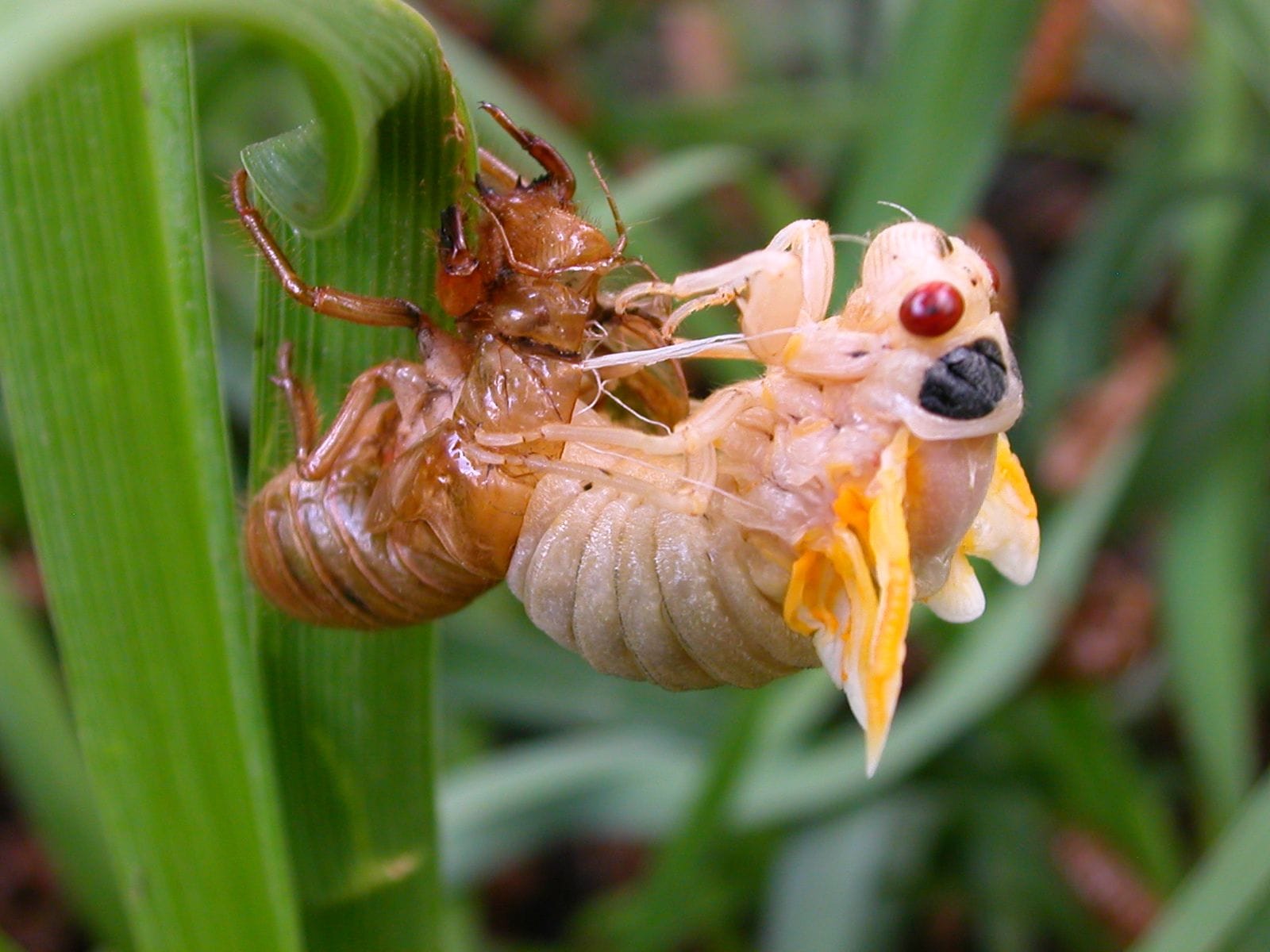Ever wondered what insects are secretly busy building underground when you’re walking around outside? Well, cicada nymphs are the masterminds behind those underground tunnels. For years, they’ve been quietly crafting their tunnels and sipping on tree sap like it’s their job. And soon, they’ll emerge from the earth like rockstars, ready to serenade us with their summery songs. Let’s sneak a peek into the hidden world of cicada nymphs and watch as they go from underground dwellers to winged musicians of the summer air.
Unveiling the Mystery of the Cicada Nymph
Ever heard the buzzing symphony of cicadas on a hot summer day? These noisy insects have a secret: they spend a big chunk of their lives hiding underground as nymphs. Let’s dig into the world of cicada nymphs and uncover the wonders of their hidden lives!
Cicada nymphs are like the teenagers of the cicada world, spending anywhere from a couple of years to nearly two decades underground! That’s like going to elementary school and graduating from college without ever seeing the sun!
But these little guys aren’t just lounging around. They’re busy sipping on the sap of tree roots with their specialized mouthparts that work like tiny straws, allowing them to slurp up the nutrient-rich xylem fluid.
As they feast and grow, their tough outer shell, called an exoskeleton, doesn’t grow with them. So, they molt several times, shedding their old exoskeletons for roomier ones.
When the soil warms up, usually after a long period of years, millions of cicada nymphs decide it’s time to see the world. They crawl out of the ground, find a suitable spot to climb on, and undergo one final molt. This time they don’t just get bigger—they transform into adult cicadas!
This grand emergence isn’t a random event. Cicadas are synced up with nature’s clock. Some types, called periodical cicadas, emerge together in huge numbers every 13 or 17 years. This synchronized emergence is a survival strategy. With so many cicadas appearing at once, predators can’t possibly eat them all.
Cicada nymphs might seem like simple creatures, but they play a vital role in our ecosystem. Their burrowing aerates the soil, which helps plants grow. And even though they munch on tree roots, their feeding may stimulate tree pruning, keeping things tidy and healthy in the forest.
The world of cicada nymphs is full of mysteries that scientists are still trying to unravel. How do they know when to emerge after so many years underground? What triggers their synchronized cycles? Researching these fascinating creatures gives us a glimpse into the complex workings of nature and reminds us that there’s still so much to discover!
So, the next time you hear the buzz of cicadas on a warm summer day, take a moment to appreciate the incredible journey of these underground dwellers. Their secret lives remind us that even in the quietest corners of our planet, nature is always up to something amazing.
What is a Cicada Nymph?
We’ve talked about those buzzing cicadas that announce the arrival of summer, but did you know they spend most of their lives hiding out underground as nymphs?
Picture this: cicada nymphs are like the teenagers of the cicada world. They’re not quite the full-fledged, winged adults yet, so they hang out underground, waiting for their big debut. But these nymphs aren’t just lounging around. They’re like tiny excavators, using their powerful front legs to tunnel through the soil, which helps aerate the ground.
While underground, they munch on tree roots. As they eat and grow, they shed their skin multiple times – a process called molting. Each molt brings them one step closer to adulthood and their eventual grand exit from their underground world. And when the time is just right, they emerge, transforming into those noisy, flying insects we know and maybe love to hate during those hot summer months.
So, next time you hear a cicada singing its heart out, remember that little nymph, working hard underground, playing its essential role in the circle of life.
How to Find Cicada Nymphs
You already know that cicada nymphs live secret lives underground for years before they come out as adults, right? They’re pretty cool little creatures that are super important for our environment. Want to find some? Here’s how you can become a cicada nymph detective:
1. Become a Chimney Hunter
Cicada nymphs aren’t exactly subtle when they’re getting ready to emerge. They dig these tunnels, called “emergence tunnels,” to reach the surface. As they dig, they push up little mounds of dirt that look like tiny chimneys. These “cicada chimneys” are usually found around the base of trees. So, if you see a small, volcano-shaped pile of dirt near a tree, there’s a good chance a cicada nymph is getting ready to clock out from its underground apartment!
2. Seek Out the Exits
Once a nymph has left, it leaves behind a telltale sign: a perfectly round hole, about the size of a pencil. These “emergence holes” are a surefire way to know that a cicada nymph has flown the coop. Look for these holes around the base of trees and in areas where you’ve seen cicada chimneys.
3. Explore the Root System
Remember, cicada nymphs spend all those years underground munching on tree roots. This means they’re often found hanging out near their food source. If you’re feeling adventurous, you can try digging carefully around the roots of trees. You might just unearth a cicada nymph or two!
Important Note: Cicada nymphs are delicate creatures, so it’s important to be respectful of their homes. When digging around trees, be gentle and avoid damaging the roots.
While we have a good understanding of cicada nymphs, there’s still much we can learn about them! Ongoing research continues to shed light on their fascinating life cycle and their importance in the ecosystem. So, keep your eyes peeled, and you never know what you might discover about these mysterious little insects!
Why Are Some Cicadas Called 17-Year Cicadas?
We’ve talked about how cicadas spend a big chunk of their lives chilling underground as nymphs. But here’s the real head-scratcher: why do some species stay down there for 17 years?
Scientists believe this 17-year cycle is a clever move to outsmart predators. If they popped up every year, predators would know exactly when and where to find them. But when they only show up every 17 years, it throws a wrench in their plans. By the time the next batch emerges, the predators that were around before might have moved on or even died out.
And get this: that 17-year cycle isn’t just a random number. It’s a prime number, which makes it even more effective. Many predators have life cycles that are 2, 3, or even 5 years long. But with a 17-year cycle, the cicadas are way less likely to bump into those predators at the same time. It’s like they’re playing a cosmic game of hide-and-seek, and they’re winning!
Of course, we don’t know for sure if this is the whole story. There’s still a lot we’re learning about these mysterious creatures. But one thing’s for sure: the 17-year cicada is a testament to the power of evolution and the incredible ways that life finds a way to thrive, even in the most unexpected places.
Do you want to learn more about the chamaeleo calyptratus? This page has all the information you need.
Want to learn more about clever carolinas? We have documented a page with all the details.
- Crypto Quotes’ Red Flags: Avoid Costly Mistakes - June 30, 2025
- Unlock Inspirational Crypto Quotes: Future Predictions - June 30, 2025
- Famous Bitcoin Quotes: A Deep Dive into Crypto’s History - June 30, 2025
















